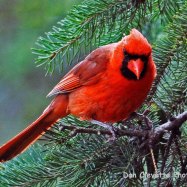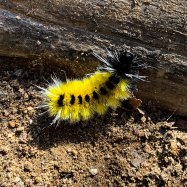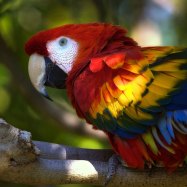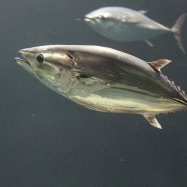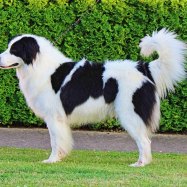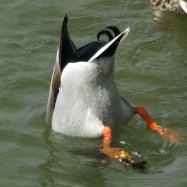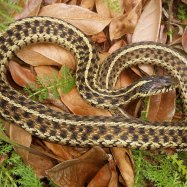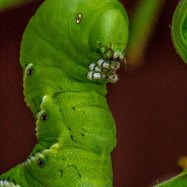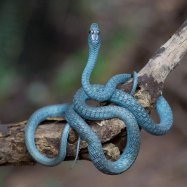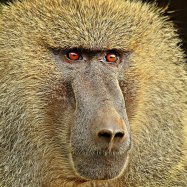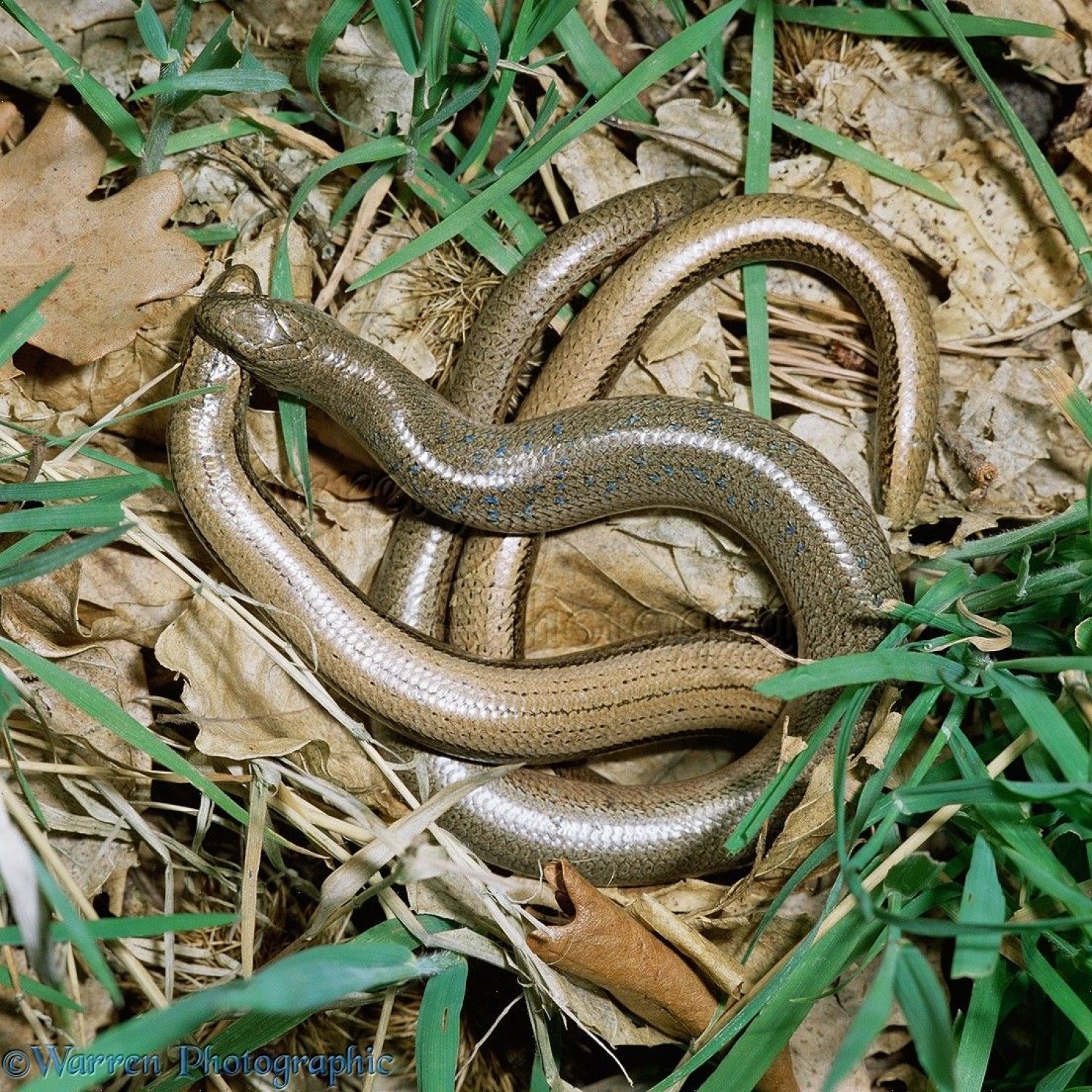
Slow Worm
Up to 50 centimeters
The Slow Worm, also known as Anguis fragilis, is a small legless lizard found in various habitats. It is not actually a snake, despite its appearance. They can grow up to 50 cm, with a long and slender body. As a member of the Anguidae family, they are harmless to humans and play an important role in the ecosystem. Look out for this fascinating creature on your next outdoor adventure. #SlowWorm #Anguidae #Lizard #Wildlife
Animal Details Summary:
Common Name: Slow Worm
Kingdom: Animalia
Habitat: Grasslands, heathlands, meadows, and gardens
The Mysterious Slow Worm: A Slithery Wonder of Nature
In a world full of magnificent animals, some creatures tend to fly under the radar and not receive the admiration they deserve. The slow worm, with its peculiar name, falls perfectly into this category. This reptile, also known as Anguis fragilis, may seem like a worm at first glance, but it is, in fact, a legless lizard. With a long slender body, brown or gray coloration, and an unassuming nature, the slow worm has been quietly navigating through its natural habitats for centuries Slow Worm. However, its understated appearance and elusive nature make it a fascinating subject of study for scientists and wildlife enthusiasts alike.Sneaky by Nature: The Slow Worm's Survival Tactics
One of the most intriguing features of the slow worm is its ability to evade predators using unique survival tactics. As a legless lizard, it has no limbs, which means it can't run away like most reptiles. Instead, it has developed a set of behaviors that help it survive in the wild. The slow worm prefers to inhabit areas with low vegetation cover, such as grasslands, heathlands, meadows, and gardens. This preference allows it to blend in with its surroundings and stay hidden from potential predators like birds of prey, small mammals, and other snakes.Further, the slow worm is a master of disguise, making it hard for predators to spot it. Its brown or grey coloration helps it blend in with the soil, leaves, and other debris on the ground. The scales on its body are also keeled, allowing for better grip and reducing the risk of slipping in its natural habitat Shantungosaurus. When threatened, the slow worm may also release a foul-smelling odor, making it unappealing to predators. These survival tactics have made it possible for the slow worm to thrive in various habitats within its range, ranging from Spain to Russia and even parts of Central Asia.
A Carnivorous Diet: What Does the Slow Worm Eat?
Although commonly mistaken for a worm, the slow worm is, in fact, a carnivore. Its diet mainly consists of insects, snails, slugs, and earthworms. It is also known to prey on small lizards, young rodents, and even other slow worms. Being an ambush predator, the slow worm patiently waits for its prey to come within reach before striking with lightning speed and consuming it whole.Interestingly, the slow worm's feeding method plays a crucial role in maintaining the ecological balance in its habitat. By controlling the population of insects and other small creatures, the slow worm helps maintain a healthy ecosystem. Thus, this unassuming creature plays a vital role in the delicate balance of the natural world.
Exploring the Slow Worm's Origins
The slow worm may have an elusive nature, but its origins and distribution are well-documented. Its scientific name, Anguis fragilis, translates to 'fragile snake,' referring to the facile nature of its tail, which can easily break off when grabbed by predators. This defense mechanism allows the slow worm to escape and regenerate the tail later, making it a truly remarkable creature.The slow worm is native to various countries in Europe and Asia, making it a widely distributed species. Its range extends from the Iberian Peninsula in the west to western Russia and the Urals in the east. It is also found in Central Asia, including parts of Kazakhstan and Siberia. The slow worm prefers a moderate climate, and although it has been introduced to North America, it is not considered invasive as it cannot survive in extreme temperatures.
The Slow Worm's Unique Adaptations
Apart from its ability to regenerate its tail, the slow worm has other remarkable adaptations that help it survive in the wild. As a legless lizard, it has a unique respiratory system where it breathes through its skin. This respiratory ability allows the slow worm to remain hidden for extended periods, making it harder for predators to detect its presence. Additionally, the slow worm's long, slender body is perfect for burrowing and navigating through its underground habitat.One of the most interesting adaptations of the slow worm is its ability to undergo parthenogenesis. This phenomenon, also known as 'virgin birth,' allows the slow worm to reproduce without the involvement of males. Females can produce offspring by duplicating their genetic material and creating clones of themselves. This adaptation ensures that the slow worm can quickly populate an area, making it an integral part of the ecosystem.
The Slow Worm and Humans: A Harmless Coexistence
Despite its impressive adaptations and crucial role in the ecosystem, the slow worm remains relatively unknown outside of scientific circles. This lack of awareness has led to misconceptions and fear of this harmless creature among humans. Some may mistake it for a snake, while others may think it is a dangerous worm.In reality, the slow worm poses no threat to humans. It has no venom and lacks the strength to constrict prey. It is also non-aggressive and will only bite if it feels threatened. The slow worm's elusive nature also means that they are not commonly seen, and many people may live in the same area without ever realizing they have these fascinating creatures in their backyard. However, with expanding urbanization and loss of natural habitats, the slow worm's population is declining in some areas. Therefore, it is essential to educate the public and promote coexistence with this innocent reptile.
The Slow Worm and Conservation Efforts
While the slow worm is not currently listed as a threatened species, its population is declining in various parts of its range. As mentioned earlier, the slow worm prefers habitats with low vegetation cover, but with land being cleared for development or agriculture, its natural home is being destroyed. Furthermore, like many other reptiles, it is susceptible to pollution and loss of prey, further contributing to its declining population.Fortunately, several conservation efforts are underway to protect the slow worm and its habitat. One such initiative is the Slow Worm Project in the United Kingdom, which aims to promote the understanding and conservation of this enigmatic creature. The project involves citizen science initiatives, where people can report sightings, helping to track the slow worm's distribution and abundance. There are also efforts to create and maintain suitable habitats for the slow worm, such as wildlife-friendly gardens and protected areas.
In Conclusion: A Real-Life Slithery Wonder
In a world where everyone seems to be in a hurry, the slow worm stands out with its relaxed and stealthy nature. Its unassuming appearance and hidden lifestyle may have prevented it from receiving the recognition it deserves, but there is no doubt that it is a remarkable creature. With its unique adaptations, crucial role in the ecosystem, and peaceful coexistence with humans, the slow worm is a true example of the wonders of nature. As scientists continue to study and learn about this mysterious reptile, it is up to us to ensure its survival and appreciate the slow worm for the remarkable creature that it is.

Slow Worm
Animal Details Slow Worm - Scientific Name: Anguis fragilis
- Category: Animals S
- Scientific Name: Anguis fragilis
- Common Name: Slow Worm
- Kingdom: Animalia
- Phylum: Chordata
- Class: Reptilia
- Order: Squamata
- Family: Anguidae
- Habitat: Grasslands, heathlands, meadows, and gardens
- Feeding Method: Carnivorous
- Geographical Distribution: Europe and parts of Asia
- Country of Origin: Various countries in Europe and Asia
- Location: Various habitats within its range
- Animal Coloration: Varies, but typically brown or gray
- Body Shape: Long and slender
- Length: Up to 50 centimeters
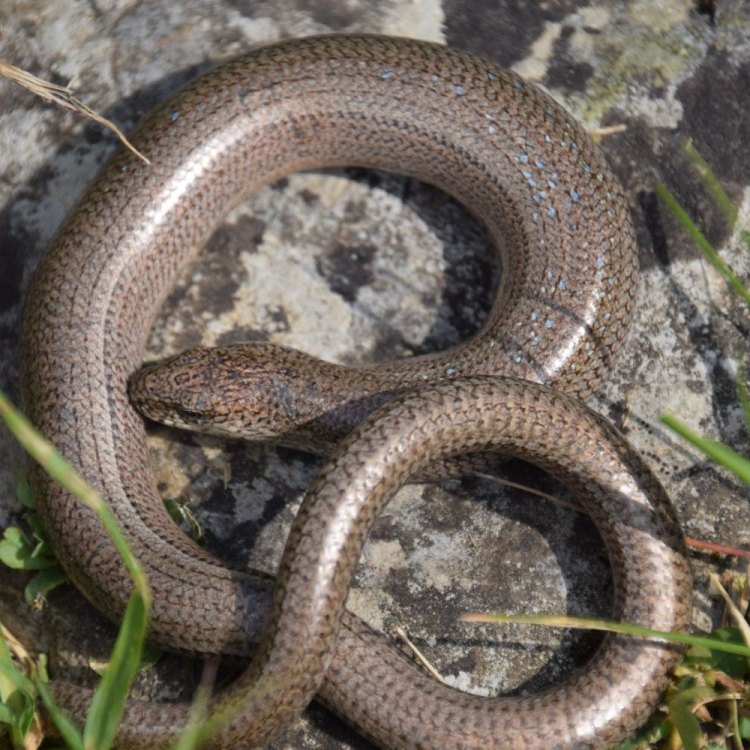
Slow Worm
- Adult Size: Around 40-50 centimeters
- Average Lifespan: Around 20 years
- Reproduction: Oviparous
- Reproductive Behavior: Mating occurs in spring and females lay eggs in early summer
- Sound or Call: Does not produce vocalizations
- Migration Pattern: Non-migratory
- Social Groups: Solitary
- Behavior: Terrestrial and secretive
- Threats: Habitat loss, fragmentation, and degradation
- Conservation Status: Least Concern
- Impact on Ecosystem: Feeds on slugs and other invertebrates, which helps control their populations
- Human Use: Not used by humans
- Distinctive Features: Limbless, shiny scales, and lack of eyelids
- Interesting Facts: Slow worms are not actually worms, but legless lizards
- Predator: Birds, mammals, and larger reptiles
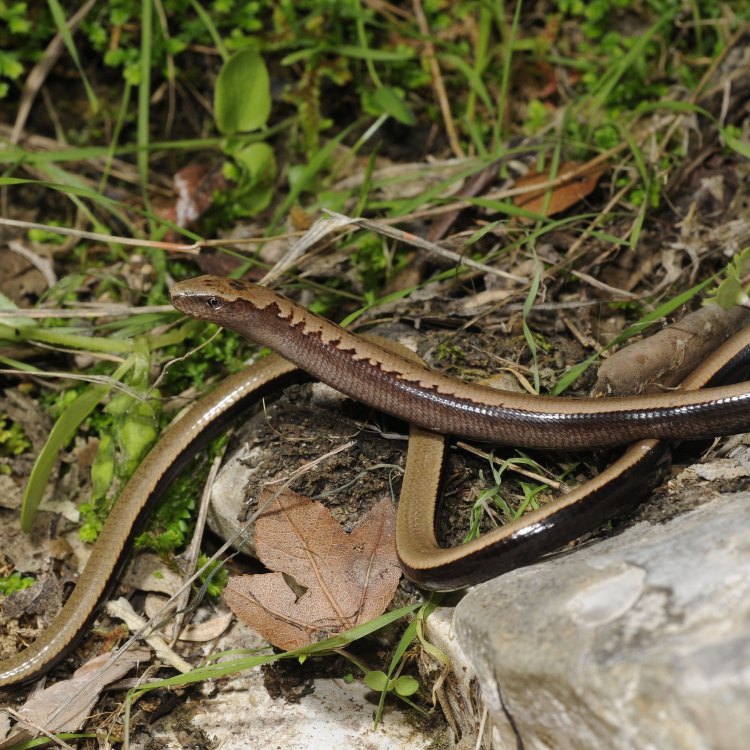
Anguis fragilis
The Fascinating Slow Worm: A Legless Lizard with Unique Features
When you think of a worm, the image that comes to mind is probably that of a long, slimy, and limbless creature. But what if I told you that there is a creature called the slow worm that fits this description, but is not actually a worm? The slow worm, also known as Anguis fragilis, is in fact a legless lizard with unique features that make it stand out in the world of reptiles.Found in parts of Europe and Asia, the slow worm is not as well-known or appreciated as other reptiles like snakes and lizards. However, upon closer inspection, it becomes clear that this seemingly simple creature has many interesting characteristics and plays an important role in its ecosystem PeaceOfAnimals.Com. In this article, we will dive into the world of the slow worm and explore its distinctive features, behavior, and impact on the environment.
Size and Lifespan
The slow worm may look like a snake at first glance, but it is actually a lizard with no legs. It has a long, slender body measuring around 40-50 centimeters in length, making it smaller than most lizards. However, what makes it truly fascinating is its average lifespan of around 20 years. This is significantly longer than other lizards of similar size and is a testament to the species' resilience and adaptability.Reproduction and Mating Behavior
As the slow worm is an oviparous species, it reproduces by laying eggs. Mating typically occurs in the spring, and females lay their eggs in early summer. Interestingly, slow worms take part in a mating ritual where the male bites the female's neck during courtship. This behavior is believed to help synchronize their reproductive cycles Swallowtail Caterpillar.Social Groups and Behavior
Unlike many other reptiles that are social animals, the slow worm is a solitary creature. It prefers to live and hunt alone, rarely interacting with other slow worms except during mating season. Additionally, slow worms are terrestrial and prefer to live underground, hiding in soil or leaf litter. This makes them elusive and secretive, making it challenging for researchers to study their behavior.Habitat and Threats
Slow worms are found in a variety of habitats, including grasslands, woodlands, and gardens. They are most commonly found in areas with a good supply of potential prey, such as slugs and other invertebrates. However, their habitat is under threat due to human activities such as habitat loss, fragmentation, and degradation. This can have severe consequences for the slow worm and other species that depend on the same habitat.Conservation Status and Impact on the Ecosystem
Despite the threats to its habitat, the slow worm is currently listed as Least Concern on the IUCN Red List. This is due to its wide geographic range and stable population. However, this status does not take into account the decline in local populations in some areas.The slow worm plays a crucial role in its ecosystem. As a predator, it feeds on slugs and other invertebrates, helping to control their populations. This is especially important for gardens and agricultural areas, where slugs can cause significant damage to plants. Therefore, the slow worm's presence can have a positive impact on its environment, making it an essential part of its ecosystem.
Distinctive Features and Interesting Facts
One of the most distinctive features of the slow worm is its limbless body. While snakes also lack legs, the slow worm has a few key differences. For example, it has movable eyelids, while snakes have transparent scales for eye protection. Additionally, the slow worm has smooth, shiny scales, while snakes can have rough scales. These unique features are what make the slow worm stand out and help differentiate it from other reptiles.Another interesting fact about the slow worm is that it is often mistaken for a worm. Its long, slender body and lack of limbs can make it look like a giant earthworm. However, the slow worm is actually more closely related to lizards, and its scientific name, Anguis fragilis, translates to "fragile snake." This not only shows the resemblance between the slow worm and snakes but also highlights its delicate nature as its tail can easily break off if grabbed by a predator.
Predators and Human Use
Like other animals, the slow worm faces threats from predators in its environment. Birds, mammals, and larger reptiles, such as other lizards or snakes, all pose a threat to the slow worm. Additionally, humans can also harm slow worms through habitat destruction and the use of pesticides, which can have a detrimental effect on their prey.Despite its unique features and positive impact on its environment, the slow worm is not used by humans for any purposes. It has no commercial value, and unlike other lizards, it is not kept as a pet. This is partly due to its elusive nature, as well as its protected status in many countries.
Conclusion
In conclusion, the slow worm may not be the first reptile that comes to mind when thinking of lizards, but it has many fascinating features and plays a vital role in its ecosystem. Its long lifespan, reproductive behavior, and unique physical characteristics make it a truly remarkable and resilient species. However, its habitat is under threat, and conservation efforts must be made to ensure its survival. The slow worm may be slow-moving, but its impact on the ecosystem is anything but sluggish, making it a crucial species to protect and preserve.
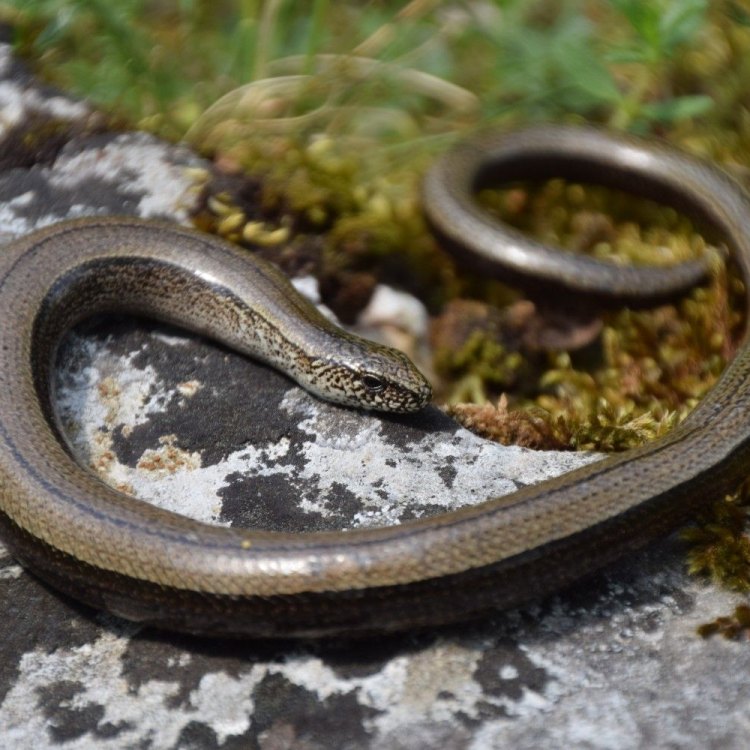
The Mysterious Slow Worm: A Slithery Wonder of Nature
Disclaimer: The content provided is for informational purposes only. We cannot guarantee the accuracy of the information on this page 100%. All information provided here may change without prior notice.

